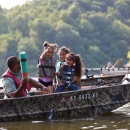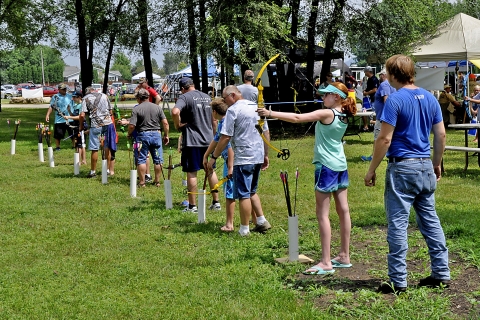About Us
The Whitney Genetics Laboratory:
- Supports control and management of invasive carp species by providing monitoring data
- Uses environmental DNA techniques to help prevent invasive carp from establishing sustainable populations in the Great Lakes
- Develops eDNA and next-generation sequencing tools to detect and monitor aquatic invasive species invasive species
An invasive species is any plant or animal that has spread or been introduced into a new area where they are, or could, cause harm to the environment, economy, or human, animal, or plant health. Their unwelcome presence can destroy ecosystems and cost millions of dollars.
Learn more about invasive species and threatened and endangered species - Works with numerous partners to complete the U.S. Fish and Wildlife Service mission
What We Do
At the Whitney Genetics Lab, we protect our aquatic habitats by playing an important part in early detection of invasive carp. Staff at the Midwest Fisheries Center and our partners collect and send thousands of eDNA samples to the Whitney Genetics Lab a year to be processed. eDNA is a useful tool used by managers to determine if more management action is needed to control invasive carp populations. We are expanding the use of eDNA to detect certain endangered species, and other invasive species invasive species
An invasive species is any plant or animal that has spread or been introduced into a new area where they are, or could, cause harm to the environment, economy, or human, animal, or plant health. Their unwelcome presence can destroy ecosystems and cost millions of dollars.
Learn more about invasive species in the region.
Our Organization
The Whitney Genetics Laboratory is housed within the Midwest Fisheries Center, which also includes the La Crosse Fish and Wildlife Conservation Office, La Crosse Fish Health Center, and administrative, GIS and outreach staff.
The Midwest Fisheries Center is the region’s Fish Technology Center for U.S. Fish and Wildlife Service. Fish Technology Centers provide leadership in science-based management of trust aquatic resources through applied research and the development of new concepts, strategies and techniques to solve problems in aquatic resource conservation. Established in 2015, the Midwest Fisheries Center’s mission is: “Working in partnership, we provide leadership in science, technology and education for conservation of aquatic ecosystems emphasizing fisheries, aquatic invasive species invasive species
An invasive species is any plant or animal that has spread or been introduced into a new area where they are, or could, cause harm to the environment, economy, or human, animal, or plant health. Their unwelcome presence can destroy ecosystems and cost millions of dollars.
Learn more about invasive species , genetics and aquatic animal health for the benefit of the public”.
Our Species
The Whitney Genetics Lab works on detection of invasive species invasive species
An invasive species is any plant or animal that has spread or been introduced into a new area where they are, or could, cause harm to the environment, economy, or human, animal, or plant health. Their unwelcome presence can destroy ecosystems and cost millions of dollars.
Learn more about invasive species including the highly invasive bighead and silver carp, and the potentially damaging black and grass carp. In addition, the lab works on sensitive species, including the eastern hellbender ,Ozark cavefish, and Wood turtle.
Projects and Research
Invasive Carp eDNA Monitoring Program (ICeM)
Roughly 9,000-10,000 eDNA samples are collected from the Upper Mississippi River and Great Lakes watersheds annually. Samples are processed at the WGL using qPCR techniques and are typically run between April-December, sometimes, with a short break.
Genetic Surveillance of Invasive Species (GeneSIS)
The Whitney Genetics Lab is collaborating with the Northeast Fishery Center to develop a Metabarcoding Early Detection and Monitoring program. The program is being developed to aid Fish and Wildlife Conservation Offices to be more efficient in monitoring efforts to detect aquatic invasive species invasive species
An invasive species is any plant or animal that has spread or been introduced into a new area where they are, or could, cause harm to the environment, economy, or human, animal, or plant health. Their unwelcome presence can destroy ecosystems and cost millions of dollars.
Learn more about invasive species early. The program is critical to the mission of the U.S. Fish and Wildlife Service's Fish and Aquatic Conservation program to manage aquatic invasive species. Sample timing is still being investigated but will likely occur April-October each year.
Other Projects
- Marker Design, Development, and Validation
- Method Improvement for eDNA Monitoring Programs
- eDNA monitoring for endangered and threatened species
- Species ID using Sanger Sequencing
Visit Us
Outreach Programs
The Whitney Genetics Lab is part of the Midwest Fisheries Center and provides all the same outreach programs available at the Center. All of the programs we offer are free of charge. You can either come visit us for a tour or we can accommodate your needs by coming to you or meeting you at a designated location. We serve the La Crosse area and surrounding counties in all nearby states.
Get Involved
The Midwest Fisheries Center offers environmental education activities for community groups and schools. In addition, the center can lend fishing poles to local community groups. Each year, the center co-sponsors several events in the community. There are a variety of volunteer opportunities available in several different areas.








